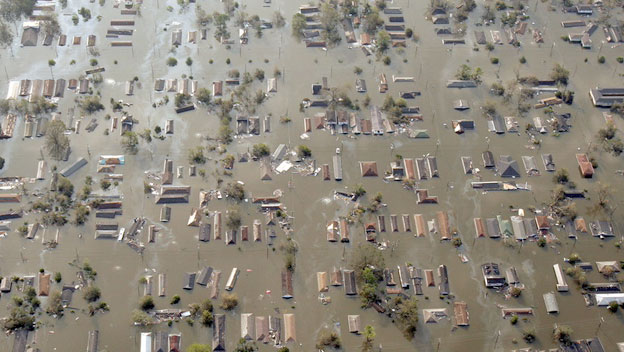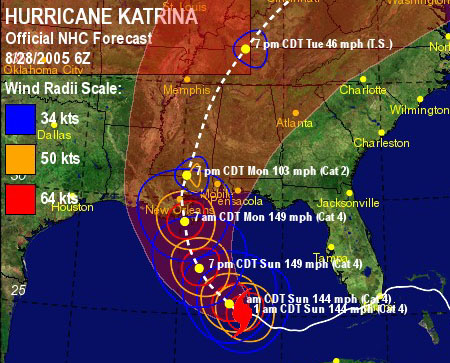A decade of healing
When Hurricane Katrina made landfall on the U.S. Gulf coast at New Orleans, Louisiana, on Sept. 29, 2005, the storm unleashed flood waters that devastated families, businesses and livelihoods.
The single most catastrophic natural disaster in U.S. history

Katrina fatalities, direct and indirect, were tallied at 1,833, according to CNN. Photo: History.com
CNN remembered the storm like this: “According to FEMA, Katrina is the single most catastrophic natural disaster in U.S. history. The total damage for Katrina is estimated at $108 billion. This makes it the costliest hurricane in U.S. history.”
But the full on human-related costs were much higher than the number reflected in the official damage ledger. 40% of the [1,577] deaths in Louisiana were caused by drowning. 25% were caused by injury and trauma and 11% were caused by heart conditions. Nearly half the fatalities in Louisiana were people over the age of 74, according to CNN.
According to a FEMA web page, “more than $19.6 billion in federal disaster assistance has made its way to Louisiana cities, parishes and citizens. That includes nearly $5.8 billion in Individual Assistance grants provided to nearly 916,000 individuals and families affected by hurricanes Katrina and Rita in Louisiana. More than $5.5 billion of the total was provided within a year of the storms, giving residents a helping hand in rebuilding their lives and restoring livelihoods. Separately, the state and FEMA provided more than $321.5 million in Disaster Unemployment Assistance to nearly 185,000 survivors who lost jobs as a result of the hurricanes, and $17.9 million in Relocation Assistance so more than 10,000 families could return home to their communities. Through collaborative efforts, FEMA and GOHSEP conducted the largest housing operation in our nation’s history, providing temporary housing to nearly 74,000 families displaced by Katrina and another 11,000 families displaced by Rita. As of three years ago, all of these survivors had returned to longer-term housing.”

Damage: New Orleans area map itemizing degree of destruction to neighborhoods from Hurricane Katrina – Map: LSU
CNN reports that “Hurricane Katrina is the costliest disaster in the history of the global insurance industry. Insurance companies have paid an estimated $41.1 billion on 1.7 million different claims for damage to vehicles, homes, and businesses in six states.”
Former FEMA head, Michael Brown, who was in charge of FEMA during Hurricane Katrina, wrote a retrospective look at the disaster that was published yesterday in Politico, entitled: “Stop Blaming Me for Hurricane Katrina.”
“While I was [on TV] urging people to leave New Orleans, Mayor Nagin announced a ‘shelter of last resort’, the New Orleans Superdome. In other words, despite calls to evacuate, if you choose not to evacuate, or are now unable to evacuate because you lack transportation, run to the Superdome.
“Nagin finally asked people to evacuate on Sunday morning for a storm that hit his city sometime after midnight that night. By that point, Amtrak had left the city with rail cars sans passengers. Airlines had evacuated Louis Armstrong International Airport with planes sans travelers. And school buses sat in their lots, soon to be flooded and ruined. The mayor’s incompetence cost lives.
“I was livid,” Brown said in the Politico article.
K+10: Healing and moving forward—Louisiana style
The American spirit is resilient. Who better to demonstrate that than the people of New Orleans and surrounding communities along the Gulf coast who lived through the disaster? Ten years after that storm ruined so many lives, the people of New Orleans are honoring those who suffered by celebrating the city’s heroes and reflecting on the lessons of the tragedy with healing circles, twilight concerts, operas, book signings, poetry sessions, panel discussions, original music, special dinners, film screenings, photo exhibits and about 100 other events planned and put on by New Orleans citizen groups and local businesses.
Below are descriptions of just two of the festivities from the Times-Picayune’s list of heavily New Orleans-flavored Katrina events. These reflect a high-spirited community that has figured out how to move forward while still in the process of healing from the ravages of the single most catastrophic natural disaster in U.S. history—10 years later:
Lower 9 Resilience Festival Andrew P. Sanchez Community Center, 1616 Caffin Ave. The two-day event marks the 10th anniversary of Hurricane Katrina with commemorations, cultural events, sneak preview of “Fear No Gumbo” by Kimberly Roberts, music, food, health screenings, and more, Aug. 28 from 5:30 to 9 p.m. and Aug. 29 from 1 to 7:30 p.m. Entertainers include 9th Ward Hunters Mardi Gras Indians, Lower 9 Express Band, 9th Ward Improv Opera, Herlin Riley and Shamarr Allen, Creole Hunters and Lil Puma, and more. Call 504.248.8594.
Katrina: Mother-in-Law of ‘Em All Joy Theater, 1200 Canal St. Joy Productions and Jonathan Mares Productions present Rob Florence’s docu-theater project in which six survivors of Hurricane Katrina gather at the Mother-in-Law Lounge, where they tell their interwoven stories in round-robin fashion. Starring Troi Bechet, Zeb Hollins, Troy Poplous, Janet Shea, Rudy Rasmussen, and Sidney Smith (the last two playing themselves). There will be three performances: Aug. 28 at 8 p.m., and Aug. 29 at 2 and 8 p.m. Before each performance, musician Bruce “Sunpie” Barnes performs “1927 Flood: Songs My Father Taught Me.” In the lobby, there will be an exhibit of Tom Neff’s photographs, titled “Holding Out and Hanging On: Surviving Hurricane Katrina.” Admission: $25-$35. Call 504.208.1180.
Katrina in retrospect: hurricane risk to Gulf coast oil and gas operations is lower today – EIA/NOAA
 Hurricane Katrina and Hurricane Rita shut down almost all offshore natural gas and crude oil production for several days, and production remained at reduced levels for months.
Hurricane Katrina and Hurricane Rita shut down almost all offshore natural gas and crude oil production for several days, and production remained at reduced levels for months.
“Hurricane-related risk to total U.S. crude oil and natural gas production has decreased over recent years as the share of total U.S. production originating in the Gulf of Mexico has declined sharply. In 2003, 27% of the nation’s crude oil was produced in the Gulf of Mexico; by 2014, that share had declined to 16%. The Gulf of Mexico’s share of natural gas production has also declined from a high of 26% in 1997 to 5% in 2014,” the EIA reported today.
 “Based on NOAA’s outlook, EIA estimated in its June Short-Term Energy Outlook that storm-related disruptions in the Gulf of Mexico during the 2015 hurricane season would total 9.7 million barrels of crude oil and 15.9 billion cubic feet of natural gas, or 3.5% and 2.8% of total Gulf of Mexico oil and natural gas production, respectively, and even smaller percentages of total U.S. production. No crude oil or natural gas production in the Gulf of Mexico was shut in during the 2014 hurricane season, and EIA estimated a 14% probability that production during the current hurricane season will also be unaffected.”
“Based on NOAA’s outlook, EIA estimated in its June Short-Term Energy Outlook that storm-related disruptions in the Gulf of Mexico during the 2015 hurricane season would total 9.7 million barrels of crude oil and 15.9 billion cubic feet of natural gas, or 3.5% and 2.8% of total Gulf of Mexico oil and natural gas production, respectively, and even smaller percentages of total U.S. production. No crude oil or natural gas production in the Gulf of Mexico was shut in during the 2014 hurricane season, and EIA estimated a 14% probability that production during the current hurricane season will also be unaffected.”


